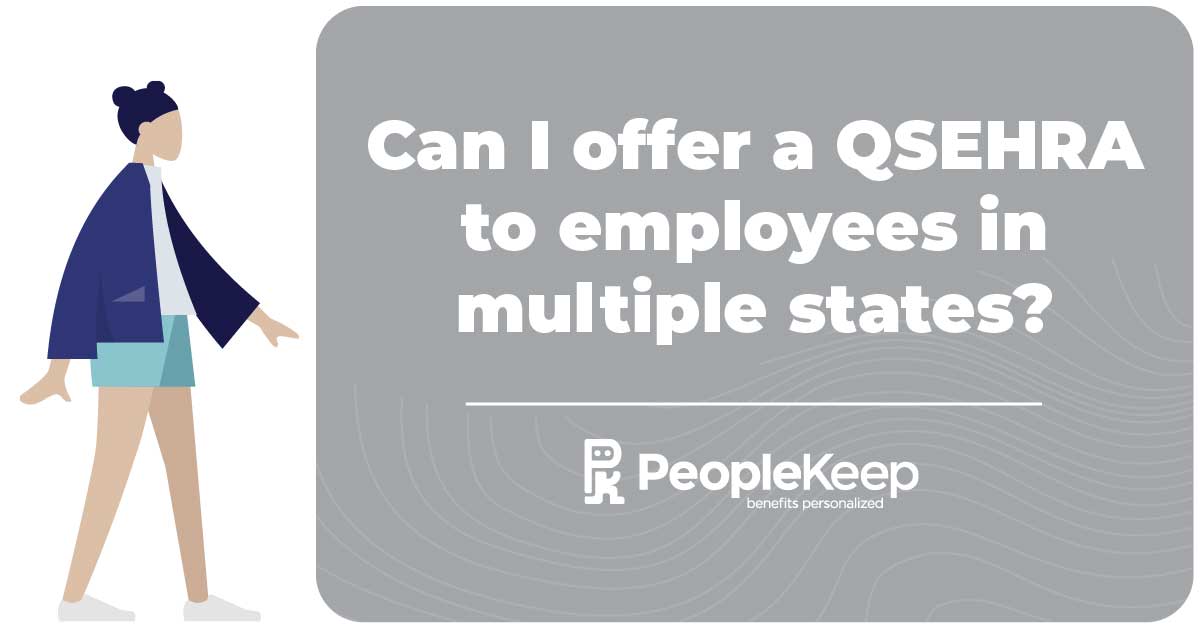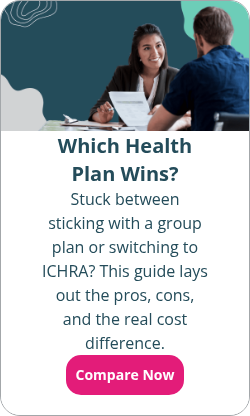How to set up an individual coverage HRA (ICHRA)
By Elizabeth Walker on October 24, 2025 at 7:45 AM
Group health insurance is the traditional employee health benefit option. But that doesn’t mean it works for every company or workforce. If you’re an employer looking for an affordable and flexible alternative to group coverage, a health reimbursement arrangement (HRA) is a great option.
With an HRA, you can provide your employees with a monthly allowance to spend on qualifying medical expenses, including individual health insurance premiums. Once employees submit proof of an eligible purchase, you reimburse them tax-free up to their allowance amount.
One type of HRA popular with employers is the individual coverage HRA (ICHRA). If you’re new to HRAs, setting up your ICHRA may seem challenging. However, when working with an ICHRA administrator, the process can be easier than you think.
The article below will walk you through the seven steps of setting up an ICHRA and discuss the advantages of using HRA administration software to help you manage your benefit.
In this blog post, you’ll learn:
- What an ICHRA is and how it works for employers and employees.
- The seven key steps to setting up an effective ICHRA benefit.
- How HRA administration software simplifies ICHRA management for employers.
What is an ICHRA?
An ICHRA is a formal health benefit that allows employers to reimburse their employees, tax-free, for their individual health plan premiums and other qualified out-of-pocket medical expenses.
Rather than offering a traditional healthcare option, you provide your eligible employees with a set monthly allowance to buy individual coverage on a public or private exchange. This saves you money on your health benefits budget and enables employees to have a more personalized health benefit that suits their unique needs.
The following are some key features of the ICHRA:
- All company sizes and industries can offer an ICHRA.
- Employees must have qualifying individual health coverage that provides minimum essential coverage (MEC), such as an ACA-compliant plan, to use the benefit.
- Employers can define benefit eligibility and allowances using 11 employee classes. They can also vary contribution allowances by age and family status.
- Unlike the qualified small employer HRA (QSEHRA), the ICHRA has no minimum or maximum contribution levels. Employers can offer as much allowance as their budget allows.
- Employers can have both an ICHRA and a group health insurance plan as part of their employee benefits program, as long as they offer one or the other to separate classes. They can’t give employees in the same class a choice between the two benefits.
Lastly, ICHRAs are particularly beneficial for applicable large employers (ALEs) looking to comply with the Affordable Care Act’s employer mandate. As long as an ALE’s ICHRA allowance is affordable, their ICHRA can meet ACA requirements if they offer the benefit to at least 95% of their full-time workers and their dependents. Employees’ qualifying individual health plans through an ICHRA will already provide MEC and minimum value.
Seven steps to setting up an ICHRA
Before offering an ICHRA at your organization, you must design your benefit compliantly. Let’s look at the seven steps of the process below.
1. Pick a start date.
First, you must decide when you want your benefit to begin. You can start an ICHRA any time during the year, so there’s no need to wait until Open Enrollment Period or January 1. Offering an ICHRA mid-year is also a qualifying event that triggers a special enrollment period (SEP) for your employees, allowing them to enroll in eligible health coverage to participate in the benefit.
Suppose you currently have an employer-sponsored health insurance plan at your company and want to switch to an ICHRA. In that case, your benefit start date should be one day after you cancel your group policy to prevent a gap in coverage.
Lastly, you generally must notify eligible employees about their new ICHRA offering at least 90 days before the benefit’s start date, or as soon as possible if shorter.
2. Choose who will be eligible.
Next, you’ll determine your benefit’s eligibility requirements. With an ICHRA, employers have a significant degree of freedom in structuring eligibility using different employee classes. For example, you could offer the ICHRA only to full-time employees, salaried employees, or those who live in a specific state.
Remember, you can provide both a traditional group health plan and an ICHRA at the same time at your company. But you can’t offer the same class of employees the choice between the two benefits.
There are no minimum class size limitations if you only offer an ICHRA. However, suppose you offer both group health insurance and an ICHRA and structure employee eligibility based on full- or part-time status, salaried or hourly pay, or geographic location. In that case, those classes must adhere to minimum class size standards.
If you’re administering your ICHRA using PeopleKeep’s software solution, only the following classes are available:
- Full-time workers
- Part-time employees
- Seasonal workers
- Salaried workers
- Non-salaried employees
- Employees in different geographic locations
If you need more customization using the 11 employee classes, PeopleKeep’s parent company, Remodel Health, can help.
3. Determine eligible expenses.
You can also customize which expenses are eligible for reimbursement. You can choose to reimburse employees for individual insurance premiums only or reimburse them for premiums and qualifying out-of-pocket medical expenses.
If you have the budget, it could be more valuable to give your employees the ability to submit reimbursement claims for both premiums and out-of-pocket costs. According to recent data, employees paid an average of $1,142 in out-of-pocket medical expenses in addition to their contribution toward employer-sponsored health coverage in 20241. So, your staff is likely to appreciate their ICHRA more if it covers a wider range of eligible expenses for reimbursement.
4. Set your employee allowance amounts.
The next step is to determine your monthly reimbursement amount, also known as a contribution allowance.
Below are three essential things to keep in mind when choosing your allowance limits:
- Your overall benefits budget.
- Remember that the ICHRA has no minimum contribution requirements or maximum limits.
- You can offer different allowance amounts to different employee classes. For example, you may want to give your salaried employees a greater allowance than your hourly workers.
- However, you must give employees within the same class the benefit on the same terms to comply with non-discrimination rules.
- In addition to classes, you can offer different allowance amounts based on an employee’s age or family size.
- If you use age to offer different allowance amounts within the same class, you can offer the oldest employees in the class at most three times the allowance of the youngest employees in the class.
5. Provide legal plan documents.
Both the IRS and the Department of Labor require that you establish a formal plan document, summary plan description (SPD), and summary of benefits and coverage (SBC) when designing any employer-sponsored group health plan, which, under federal law, includes the ICHRA.
ICHRA plan documents can be complex and confusing for employers offering the benefit for the first time.
These documents cover a significant amount of information, including:
- Eligibility requirements, including any waiting period
- Monthly allowance amounts categorized by employee classes
- Expenses eligible for reimbursement
- Claims documentation requirements
- Substantiation requirements for individual health plan attestation
- Information on how to adhere to HIPAA, FMLA, and other federal laws.
Because of this, many employers utilize an ICHRA administration software solution to ensure they’re following all the necessary requirements and aren’t subject to costly tax penalties. We’ll dive into administration software in a later section.
6. Communicate the ICHRA to employees.
The ICHRA is new to you, but it’s also brand new to your employees. Whether you’re switching to an ICHRA or offering a health benefit for the first time, communicating what’s happening is critical. For many employees, the ICHRA will be their first experience with a reimbursement-based health benefit, and they’ll need guidance.
You generally must notify your eligible employees of their new benefit at least 90 days before the start date. Newly eligible employees, such as new hires, can receive notice up until the first day the employee’s ICHRA coverage begins. But in either case, your ICHRA notice must include some required information.
For instance, your employees must know:
- A basic description of the ICHRA
- How they can obtain individual health insurance to participate in the benefit
- How to make claims for reimbursement
- Their right to opt out of the benefit
- Their ICHRA administration and relevant contact information
- How the ICHRA coordinates with premium tax credits
It’s essential to educate your employees promptly, transparently, and regularly. During your initial communication, be clear that by offering an ICHRA, you’re giving employees access to better benefits by allowing them to choose their own individual health insurance plan. If possible, follow up the initial announcement with a series of meetings to review the ICHRA and address any questions and concerns.
7. Provide resources to help employees choose individual health insurance
All employees participating in the ICHRA must have a qualifying form of individual health insurance. Uninsured employees, individuals with Medi-Share or another healthcare sharing ministry plan, and employees covered under a spouse’s group health insurance policy aren’t eligible to use the benefit.
Shopping for health insurance may be new for many employees. As their employer, you’re a valuable resource and likely the first point of contact they turn to when they need help. Provide your employees with information on where they can compare on- and off-market options and shop for health plan coverage on the individual market, along with contact details if they need further help.
Just remember that the federal government prohibits you from directly advising employees on which policy to choose. You can give them general information and support, but compliance regulations dictate that you can’t influence purchasing decisions or endorse any specific issuer or insurance policy.
If you use PeopleKeep or Remodel Health to administer your ICHRA, your employees can also shop for health coverage right from their accounts. This makes the process much easier for your employees.
How to manage an ICHRA with HRA administration software
While it’s possible to self-administer your ICHRA, experts don’t recommend it.
Offering and administering an ICHRA requires you to:
- Create legal plan documents and employee notices.
- Collect, process, and store employee reimbursement requests.
- Monitor the healthcare landscape for changing regulations.
- Ensure employees’ documents are private and secure.
In addition to being tedious and time-consuming, self-administration comes with compliance regulations. This may put some employers at financial risk of expensive penalties if they make a mistake. Additionally, any mistakes made regarding privacy or compliant administration could violate federal law and employees’ trust.
For these and other reasons, many employers use HRA administration software to manage their ICHRA. An HRA software solution will allow you to administer your ICHRA online, easily record reimbursement amounts, and update plan documents. Most importantly, the software will help you stay compliant with all current laws and regulations.
PeopleKeep’s HRA software offers employers a single-source solution for their ICHRA administration needs. We generate plan documents, assist with plan design, review and store employee documentation, and help employees purchase individual health plans. Additionally, our award-winning support team helps your employees get to know their ICHRA and promptly addresses their questions and concerns, allowing you to focus on your business.
Suppose you have more complex needs and require hands-on support. In that case, Remodel Health’s ICHRA+® administration solution provides advanced support, compliance tools, automated premium payments, and educational materials to help you manage a larger-scale benefit for more diverse workforces.
Conclusion
Employees in today’s workplace want personalized employee benefits. With an ICHRA, you can save money while providing your employees with a customizable and flexible health benefit that can meet all their diverse needs. Although it may be an unfamiliar process initially, setting up an ICHRA doesn’t have to be complicated. By following the seven steps above, you’ll be on your way to offering your new benefit.
An ICHRA can be tremendously valuable for employers and employees. But you must manage it responsibly for it to be truly beneficial. With HRA administration software like PeopleKeep by Remodel Health, you can set up and administer your ICHRA with ease. Ready to get started? Schedule a call with one of our HRA specialists!
This article was originally published on March 26, 2019. It was last updated on October 24, 2025.
Check out more resources
See these related articles

What is an ICHRA?
What is an ICHRA, and how does it work? Find out everything you need to know about this innovative healthcare option: the individual coverage HRA.

HRAs and W-2 annual reporting
Learn about HRA W-2 annual reporting requirements. Understand what employers need to include on employees' W-2 forms for HRA compliance.

Can I offer a QSEHRA to employees in different states?
Have employees in multiple states? Find out how to offer QSEHRA across state lines while staying compliant and meeting varied insurance needs.



